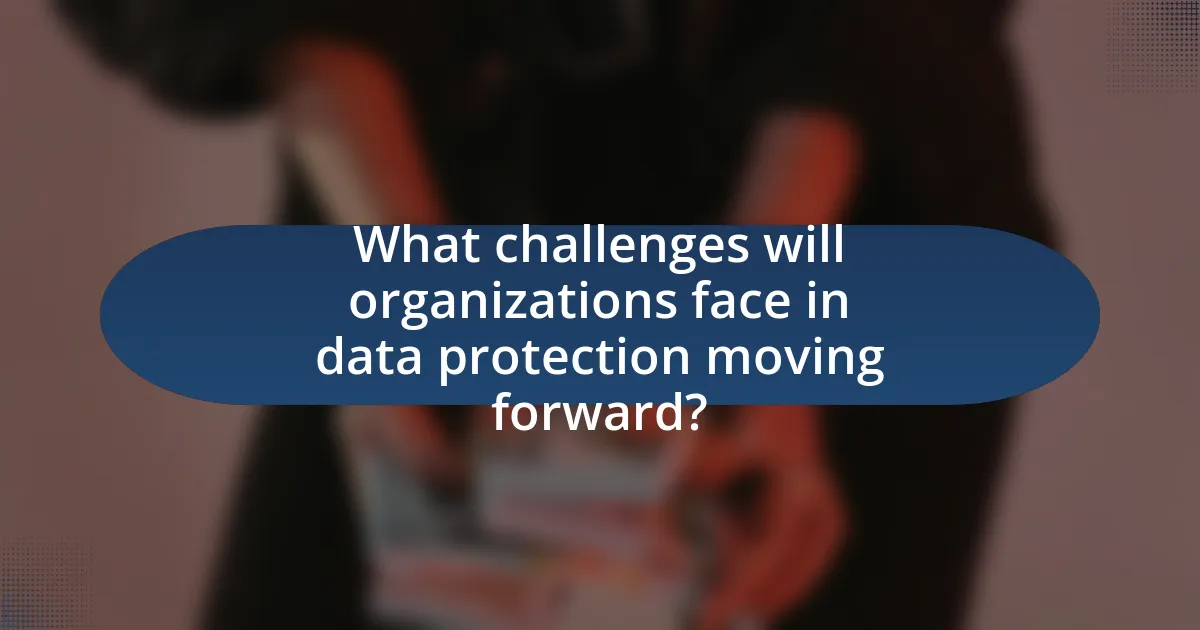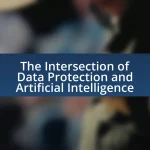The article focuses on the future of data protection, highlighting key trends and predictions that are shaping the landscape. It discusses increased regulatory scrutiny, the integration of artificial intelligence in data security, and the emphasis on privacy by design. The influence of technology, particularly advancements in cloud computing and machine learning, is examined in relation to enhancing data protection measures. Additionally, the article addresses anticipated regulatory changes, compliance challenges organizations may face, and the evolving expectations of consumers regarding data privacy. It concludes with practical strategies for organizations to strengthen their data protection efforts amidst growing cyber threats.

What are the key trends shaping the future of data protection?
Key trends shaping the future of data protection include increased regulatory scrutiny, the rise of artificial intelligence in data security, and a growing emphasis on privacy by design. Regulatory bodies worldwide, such as the European Union with its General Data Protection Regulation (GDPR), are implementing stricter compliance requirements, which compel organizations to enhance their data protection measures. The integration of artificial intelligence allows for more sophisticated threat detection and response mechanisms, improving overall security posture. Additionally, the concept of privacy by design emphasizes incorporating data protection measures from the outset of product development, ensuring that privacy is a fundamental component rather than an afterthought. These trends reflect a proactive approach to safeguarding personal data in an increasingly digital landscape.
How is technology influencing data protection trends?
Technology is significantly influencing data protection trends by enabling advanced security measures and compliance frameworks. Innovations such as artificial intelligence and machine learning enhance threat detection and response capabilities, allowing organizations to identify and mitigate risks more effectively. For instance, a report by McKinsey & Company highlights that AI-driven security systems can reduce the time to detect breaches by up to 80%. Additionally, the rise of cloud computing has prompted the development of robust encryption methods and data governance policies, ensuring that sensitive information remains secure in transit and at rest. These technological advancements are reshaping how organizations approach data protection, making it more proactive and resilient against evolving cyber threats.
What role do artificial intelligence and machine learning play in data protection?
Artificial intelligence and machine learning play a crucial role in data protection by enhancing threat detection, automating responses, and improving data privacy measures. These technologies analyze vast amounts of data in real-time to identify patterns indicative of security breaches or anomalies, allowing organizations to respond swiftly to potential threats. For instance, according to a report by McKinsey & Company, companies that implement AI-driven security solutions can reduce the time to detect and respond to incidents by up to 90%. Additionally, machine learning algorithms can continuously learn from new data, adapting to evolving threats and ensuring that data protection measures remain effective over time.
How are cloud computing advancements impacting data security?
Cloud computing advancements are significantly enhancing data security through improved encryption methods, advanced access controls, and real-time threat detection. These technologies enable organizations to protect sensitive information more effectively. For instance, the implementation of end-to-end encryption ensures that data is secure both in transit and at rest, making unauthorized access more difficult. Additionally, cloud providers often utilize machine learning algorithms to identify and respond to potential security threats in real-time, thereby reducing the risk of data breaches. According to a report by Gartner, organizations that adopt cloud security solutions can reduce the risk of data breaches by up to 60%, demonstrating the effectiveness of these advancements in safeguarding data.
What regulatory changes are expected in data protection?
Regulatory changes expected in data protection include the implementation of stricter privacy laws and enhanced enforcement mechanisms. For instance, the European Union’s General Data Protection Regulation (GDPR) has set a precedent, prompting countries worldwide to adopt similar frameworks that prioritize user consent and data minimization. Additionally, the rise of artificial intelligence and data analytics is leading to calls for regulations that address algorithmic transparency and accountability. These anticipated changes reflect a global trend towards more robust data protection standards, driven by increasing public awareness and demand for privacy rights.
How will GDPR and other regulations evolve in the coming years?
GDPR and other data protection regulations are expected to evolve towards stricter enforcement and broader applicability in the coming years. As data privacy concerns grow, regulatory bodies are likely to enhance compliance requirements and increase penalties for violations, as evidenced by the European Data Protection Board’s ongoing efforts to clarify and strengthen GDPR guidelines. Additionally, emerging technologies such as artificial intelligence and blockchain will prompt regulators to adapt existing frameworks or create new regulations to address unique privacy challenges, reflecting the trend of integrating data protection into technological advancements.
What new compliance challenges might organizations face?
Organizations may face new compliance challenges related to evolving data protection regulations, such as the General Data Protection Regulation (GDPR) and the California Consumer Privacy Act (CCPA). These regulations require organizations to implement stringent data handling practices, including obtaining explicit consent for data collection and ensuring transparency in data usage. Additionally, the rise of artificial intelligence and machine learning technologies introduces complexities in compliance, as organizations must navigate the ethical implications of automated decision-making and data bias. The increasing frequency of data breaches also necessitates enhanced security measures and incident response protocols to comply with legal obligations, such as notifying affected individuals and regulatory bodies within specified timeframes.

What predictions can be made about the future of data protection?
The future of data protection is likely to see increased regulatory measures and advanced technological solutions. As data breaches become more frequent, governments are expected to implement stricter laws, similar to the General Data Protection Regulation (GDPR) in Europe, which has already influenced global data protection standards. Additionally, the rise of artificial intelligence and machine learning will enhance data security protocols, enabling organizations to detect and respond to threats in real-time. According to a report by Cybersecurity Ventures, global spending on cybersecurity is projected to exceed $1 trillion from 2021 to 2025, indicating a significant investment in data protection technologies.
How will consumer expectations change regarding data privacy?
Consumer expectations regarding data privacy will increasingly demand greater transparency and control over personal information. As data breaches and misuse of personal data become more prevalent, consumers are becoming more aware of their rights and the importance of data protection. According to a 2022 survey by the International Association of Privacy Professionals, 79% of consumers expressed concern about how their data is being used, indicating a shift towards a demand for companies to provide clear privacy policies and options for data management. This trend suggests that consumers will expect organizations to implement robust data protection measures and to communicate these practices effectively.
What do consumers prioritize when it comes to data security?
Consumers prioritize privacy, data integrity, and transparency when it comes to data security. A survey conducted by the International Association of Privacy Professionals in 2022 revealed that 79% of consumers are concerned about how their personal data is used and shared. Additionally, 67% of respondents indicated that they would stop using a service if they felt their data was not secure. This highlights the importance consumers place on companies being transparent about their data practices and ensuring robust security measures are in place to protect personal information.
How might public awareness of data breaches influence corporate behavior?
Public awareness of data breaches significantly influences corporate behavior by prompting companies to enhance their data security measures and transparency. When consumers become aware of breaches, they often demand greater accountability and protection of their personal information, leading corporations to prioritize cybersecurity investments. For instance, after the Equifax breach in 2017, which exposed the personal data of approximately 147 million people, many companies increased their cybersecurity budgets by an average of 30% to mitigate risks and restore consumer trust. This shift in corporate behavior reflects a direct response to public concern, as organizations recognize that failing to address data security can result in reputational damage and financial losses.
What innovations are likely to emerge in data protection technologies?
Innovations likely to emerge in data protection technologies include advanced encryption methods, AI-driven threat detection, and decentralized data storage solutions. Advanced encryption methods, such as homomorphic encryption, allow data to be processed without being decrypted, enhancing security. AI-driven threat detection systems utilize machine learning algorithms to identify and respond to potential breaches in real-time, significantly reducing response times. Decentralized data storage solutions, like blockchain technology, provide enhanced security by distributing data across multiple nodes, making unauthorized access more difficult. These innovations are supported by ongoing research and development in cybersecurity, indicating a trend towards more robust and adaptive data protection measures.
How will encryption methods evolve to enhance data security?
Encryption methods will evolve to enhance data security through advancements in quantum encryption, homomorphic encryption, and AI-driven encryption techniques. Quantum encryption utilizes the principles of quantum mechanics to create secure communication channels that are theoretically immune to eavesdropping, as demonstrated by the successful implementation of quantum key distribution in various research projects. Homomorphic encryption allows computations to be performed on encrypted data without needing to decrypt it, thereby maintaining confidentiality while enabling data processing, which has been validated by studies showing its potential in cloud computing environments. Additionally, AI-driven encryption techniques will leverage machine learning algorithms to adaptively strengthen encryption protocols against emerging threats, as evidenced by ongoing research in adaptive cryptography. These advancements collectively represent a significant shift towards more robust and resilient data security frameworks.
What new tools and solutions are anticipated for data protection?
New tools and solutions anticipated for data protection include advanced encryption technologies, AI-driven threat detection systems, and decentralized data storage solutions. Advanced encryption technologies, such as homomorphic encryption, allow data to be processed without being decrypted, enhancing security. AI-driven threat detection systems utilize machine learning algorithms to identify and respond to potential threats in real-time, significantly reducing response times and improving overall security posture. Decentralized data storage solutions, like blockchain, provide enhanced security by distributing data across multiple nodes, making unauthorized access more difficult. These innovations are expected to address the growing challenges of data breaches and privacy concerns in an increasingly digital landscape.

What challenges will organizations face in data protection moving forward?
Organizations will face several challenges in data protection moving forward, including increasing regulatory requirements, evolving cyber threats, and the complexity of managing data across multiple platforms. Regulatory frameworks such as the General Data Protection Regulation (GDPR) and the California Consumer Privacy Act (CCPA) impose stringent compliance obligations, which can be resource-intensive and require continuous updates to data handling practices. Additionally, cyber threats are becoming more sophisticated, with a rise in ransomware attacks and data breaches, necessitating advanced security measures and constant vigilance. Furthermore, as organizations adopt cloud services and remote work models, the complexity of data management increases, making it difficult to maintain consistent security protocols across diverse environments. These challenges highlight the need for organizations to invest in robust data protection strategies and technologies to safeguard sensitive information effectively.
How can organizations prepare for evolving cyber threats?
Organizations can prepare for evolving cyber threats by implementing a multi-layered security strategy that includes regular risk assessments, employee training, and advanced threat detection technologies. Regular risk assessments help identify vulnerabilities and prioritize security measures, while employee training ensures that staff are aware of potential threats and best practices for cybersecurity. Advanced threat detection technologies, such as artificial intelligence and machine learning, can analyze patterns and detect anomalies in real-time, allowing organizations to respond swiftly to potential breaches. According to a report by Cybersecurity Ventures, global cybercrime damages are expected to reach $10.5 trillion annually by 2025, highlighting the urgent need for organizations to adopt proactive measures against evolving threats.
What strategies can be implemented to mitigate risks?
To mitigate risks, organizations can implement a combination of risk assessment, data encryption, employee training, and incident response planning. Risk assessment involves identifying potential vulnerabilities and threats to data, allowing organizations to prioritize their security measures effectively. Data encryption protects sensitive information by converting it into a secure format that can only be accessed by authorized users, significantly reducing the risk of data breaches. Employee training ensures that staff are aware of security protocols and best practices, which can prevent human error, a common cause of data incidents. Incident response planning prepares organizations to respond swiftly and effectively to data breaches, minimizing damage and recovery time. These strategies are supported by industry standards, such as the NIST Cybersecurity Framework, which emphasizes the importance of a comprehensive approach to risk management.
How important is employee training in data protection efforts?
Employee training is crucial in data protection efforts as it directly influences the effectiveness of security measures. Organizations with comprehensive training programs can reduce the risk of data breaches by up to 70%, according to a study by the Ponemon Institute. This highlights that well-informed employees are less likely to fall victim to phishing attacks and other security threats. Furthermore, ongoing training ensures that staff remain aware of evolving threats and compliance requirements, thereby strengthening the overall data protection framework.
What best practices should organizations adopt for effective data protection?
Organizations should adopt a multi-layered approach to data protection, which includes implementing strong encryption, regular data backups, and robust access controls. Strong encryption safeguards sensitive data both at rest and in transit, making it unreadable to unauthorized users. Regular data backups ensure that critical information can be restored in case of data loss incidents, such as cyberattacks or hardware failures. Robust access controls limit data access to authorized personnel only, reducing the risk of insider threats and data breaches. According to a 2022 report by IBM, organizations that implemented these best practices experienced 30% fewer data breaches compared to those that did not.
How can organizations ensure compliance with data protection regulations?
Organizations can ensure compliance with data protection regulations by implementing robust data governance frameworks that include regular audits, employee training, and clear data handling policies. These frameworks help organizations identify and mitigate risks associated with data processing activities, ensuring adherence to regulations such as the General Data Protection Regulation (GDPR) and the California Consumer Privacy Act (CCPA). For instance, a study by the International Association of Privacy Professionals (IAPP) found that organizations with comprehensive data protection programs are 50% less likely to experience data breaches. This demonstrates that proactive measures, such as appointing a Data Protection Officer (DPO) and conducting impact assessments, are essential for maintaining compliance and protecting consumer data.
What role does incident response planning play in data protection?
Incident response planning is crucial for data protection as it establishes a structured approach to identifying, managing, and mitigating data breaches and security incidents. This planning enables organizations to respond swiftly and effectively, minimizing potential damage and data loss. According to a study by the Ponemon Institute, organizations with an incident response plan can reduce the average cost of a data breach by approximately $1.23 million, highlighting the financial benefits of preparedness. Furthermore, effective incident response planning ensures compliance with regulations such as GDPR and HIPAA, which mandate specific protocols for data protection and breach notification.
What practical steps can organizations take to enhance their data protection strategies?
Organizations can enhance their data protection strategies by implementing a multi-layered security approach that includes encryption, access controls, and regular security audits. Encryption protects sensitive data both at rest and in transit, making it unreadable to unauthorized users. Access controls ensure that only authorized personnel can access specific data, reducing the risk of insider threats. Regular security audits help identify vulnerabilities and ensure compliance with data protection regulations, such as GDPR, which mandates strict data handling practices. According to a 2021 report by IBM, organizations that adopt a comprehensive data protection strategy can reduce the cost of data breaches by an average of $1.76 million.





